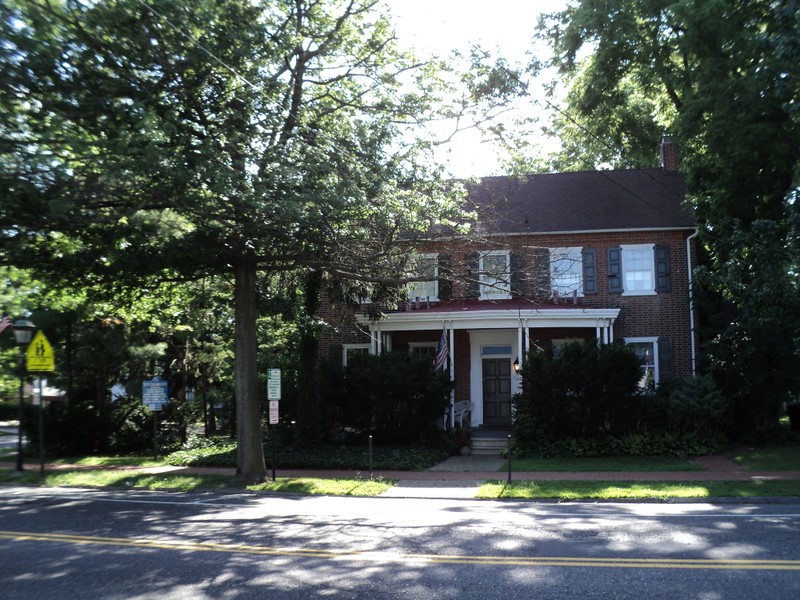Dr. George Haines House
Introduction
Text-to-speech Audio
Images
Dr. Haines House in Medford, NJ, a part of the underground railroad.

Backstory and Context
Text-to-speech Audio
Dr. George Haines was the first registered physician in Medford, helped organize the County Agricultural Society and a local bank, and evidence strongly suggests his house functioned as a stop on Underground Railroad. Haines, a Quaker and abolitionist, was a member of the Haines family who settled the Medford area in the 1680s. The family quickly took ownership of thousands of acres of land and operated a dam and mill in Medford. Dr. Haines built the historic home for his bride in 1826. While his family proved highly influential, the entire country enjoyed recognition for its place as a safe-haven for enslaved persons who were attempting to secure their freedom. At least sixteen sites in Burlington County have ties to the Underground Railroad in addition to the home of Dr. George Haines.
While in England, Richard Haines gained a land grant for the Medford area in 1682. The family quickly amassed several thousands of acres of land and controlled much of the woodlands and watershed. Richard's great-great-grandsons, Nehemiah and Issac, developed the Haines Mill (aka Kirby's Mill and the Medford Historical Society) and a corresponding home in the 1770s and 1780s, both of which are landmarks. Nehemiah's son, George, became the township's first physician while his brother, Charles, added to the mill, both physically and operationally.
Dr. George Haines worked as a physician, but he also helped establish a local bank and the County Agricultural Society. Moreover, evidence strongly points to his house serving as a hideaway for fugitive slaves. For years, the Haines, a noted Quaker abolitionist, connection to the Underground Railroad mainly lay in oral history, but renovations to the house in 1992 revealed a small secret room underneath the kitchen in the rear of the house. Its only access point was through a shaft leading from a covered opening in the corner of the kitchen floor. (Local oral tradition pointed to the rear of the house as the location where Haines hid fugitive slaves.) Dr. Andrew E. Budd, another physician, bought the house in 1845 from Haines, and it is believed by many that he continued to assist enslaved persons directly.
Cite This Entry
Powers, Mathew and Clio Admin. "Dr. George Haines House." Clio: Your Guide to History. February 22, 2021. Accessed April 22, 2025. https://theclio.com/entry/127153
Sources
"African American History." Burlington County. nj.us. Accessed February 22, 2021. http://www.co.burlington.nj.us/DocumentCenter/View/1339/African-American-History?bidId=
Coughlin, Bill. "The George Haines House." The Historical Marker Database. hmdb.org. 2020, 2011. https://www.hmdb.org/m.asp?m=44684.
Haines, John Wesley. Richard Haines and his Descendants: a Quaker family of Burlington County, New Jersey since 1682. Boyce, VA: Carr Pub. Co, 1961. Links to both volumes can be found at archives.org or through https://onlinebooks.library.upenn.edu/webbin/book//lookupid?key=olbp86912.
"George Haines House, #21." West Jersey History Project. westjerseyhistory.org. Accessed February 19, 2021. http://www.westjerseyhistory.org/books/medsites/.
New Jersey Historical Commission. "Dr. George Haines House, Medford Burlington County, NJ." PureHistory. purehistory.org. 1999. https://purehistory.org/dr-george-haines-house-medford-burlington-county-new-jersey/.
Powers, Mathew. "Miller's House (The Nehemiah Haines House) ." Clio: Your Guide to History. February 22, 2021. Accessed February 22, 2021. https://www.theclio.com/entry/127118
Switala, William J. Underground Railroad in New Jersey and New York. Mechanicsburg, PA: Stackpole Books, 2006.
Trumbower, Betty H and James G Trumbower. "Nomination Form: Jonathan Haines House - Friendship Farm." National Register of Historic Places. nps.gov. 1976. https://npgallery.nps.gov/GetAsset/89556d1f-4ae2-4ed1-9956-4b508e5ea2c6/. Though this form references Jonathan Haines, its subject is John Haines, the builder of the 1690 farmhouse on Fostertown Road. Nevertheless, the material provided gives insight into the Haines family, including Jonathan, who built the 1760 structure.
By Bill Coughlin, July 21, 2011. https://www.hmdb.org/m.asp?m=44684

